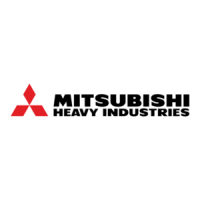
Do you have a question about the Mitsubishi Heavy Industries FDCW100VNX and is the answer not in the manual?
| Brand | Mitsubishi Heavy Industries |
|---|---|
| Model | FDCW100VNX |
| Category | Heat Pump |
| Language | English |
Essential precautions for safe installation and operation to prevent injury or damage.
Specific safety measures for handling refrigerants and installing components.
Precautions for electrical work, grounding, and wiring to prevent hazards.
Guidelines on selecting installation locations and avoiding environmental hazards.
Important notes and dedicated tools required for units designed for R410A refrigerant.
Overview of the Hydrolution system, its benefits, and key features.
Explanation of how the heat pump system works and its heating, hot water, cooling functions.
Details on the indoor unit's front panel, including symbols, buttons, and display.
Instructions on navigating menus, changing settings, and using features like key lock.
Configuration of heating modes, temperature, and heating curve settings.
Configuration of cooling modes, including operation based on outdoor sensors.
Settings for hot water production, available volume, and extra hot water functions.
Guidance on checking safety valves, draining systems, and general unit upkeep.
Addresses common issues affecting heating, hot water, and room temperature.
Explanation of alarm codes, their causes, and procedures for resetting alarms.
Guidance on haulage, location selection, space requirements, and piping work.
Instructions for transporting, assembling, and installing the indoor unit.
Details on pipe installation, overflow valves, and system requirements.
Procedures for connecting power supply, wiring, and electrical components.
Steps for system start-up, inspection, cleaning, and commissioning.
Understanding the unit's display, menu types, and navigation controls.
Overview of primary menus for hot water, supply temperature, and heat pump settings.
Detailed listing of all available menu options and their hierarchy for system configuration.
Accessing alarm logs and service menus for advanced diagnostics and settings.
Detailed explanation of the Hydrolution system's working principles and functions.
Description of heating, hot water, and cooling modes, including alternating and combined operations.
Essential requirements for installing the system correctly, covering various climate systems.
Information on integrating solar collectors, boilers, and other external heat sources.
How the indoor unit controller manages operation modes and transitions.
Control logic for the outdoor unit, including compressor speed and fan operation.
Mechanisms for protecting the system against overcurrent, freezing, and abnormal conditions.
Comprehensive list of alarms, their causes, and detailed troubleshooting steps.
Wiring diagrams for both the indoor and outdoor units, illustrating connections.
Information on sensor placement and resistance/voltage data for temperature sensors.
Diagrams showing component locations and lists of parts for indoor and outdoor units.
Technical specifications, performance data, operating ranges, and capacity diagrams.
List of optional accessories available for the system, including part numbers.